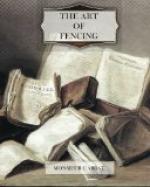Swiftness in Fencing, is so necessary, that without this Quality, it is very difficult to defend, and impossible to offend: This Truth is so well known, that every one is earnestly desirous of it, tho’ most People are ignorant of the Means necessary to acquire it.
What contributes most to the becoming swift, besides, frequent Exercise and a fine Disposition, is a perfect Situation of the Parts, the Retention of the Body, and the regular Motion of the Wrist: The Situation requires this advantageous Point of all the Parts, to communicate Freedom and Vigour to the Action, that they may act with Quickness. In order to retain the Body, it is necessary that it be always in it’s perfect Situation, during the Motions previous to the Thrust; and if the Thrust consist of one Time only, the Wrist must begin.
As to the Motion of the Hand, it must not only be animated, but also the Action must not be wide, whether in Disengagements, Engagements, Feints, or Risposts; because if you would be soon at your Mark, it is not sufficient to go quick, but it is also necessary that the Action be close.
Many People have confounded the Swiftness of pushing with precipitate or consecutive Thrusts, without considering that Precipitation is either when the Body moves before the Hand, or when an improper Motion is made; and the consecutive Thrusts, the pushing several Times without Interval, or when there is no Occasion; which may be done by one who is not swift; for Swiftness is only the Shortness of Time between the Beginning and End of an Action, as I have already said.
Swiftness and Time are very justly called the Soul of Fencing, and all Thrusts owe their Success to these Qualities; for you cannot hit but by Surprize, nor surprize but by Swiftness.
There are three Ways of surprizing in Fencing: The first is the Situation of the Guard, taking his Time: The second, is doing an Action to disorder the Enemy, in order to hit him, at that Time, where he is open; and the third is when the Opponent attacks you, either by Feints, Engagements, or Lunges, you take him upon the Time. Tho’ these three Sorts of Surprize require a certain Point of Swiftness, the first needs the most, having no other Support; but the two others have the Advantage of having disorder’d the Enemy.
Although Time, Swiftness, and the other Qualities are absolutely necessary in Fencing, without their just Concurrence they are useless. In order to acquire which, the Wrist must be easy by Practice, that you may hit where you see Light.
CHAP. XXVIII.
Of Measure.




